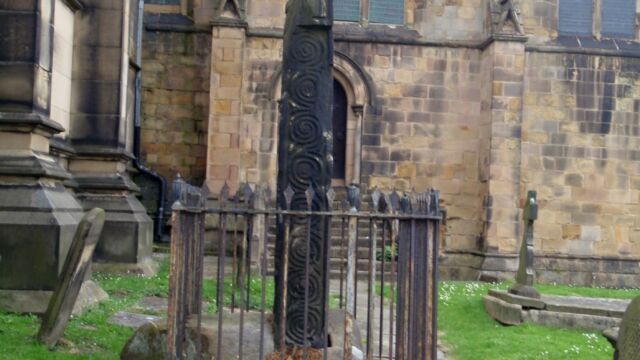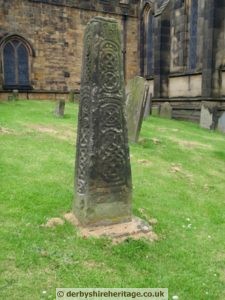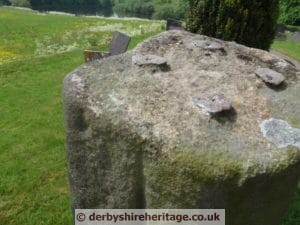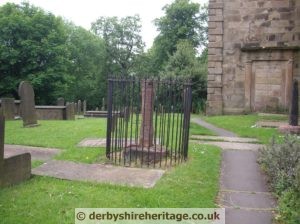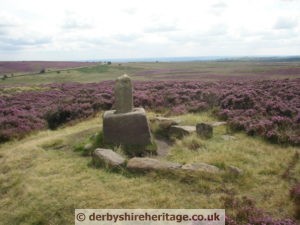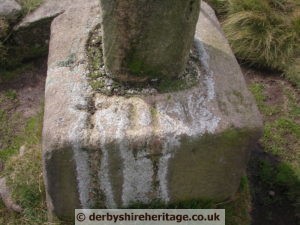INDEX of ANCIENT DERBYSHIRE CROSSES
Ancient Derbyshire crosses are often found in many churchyards and were intended to sanctify the churchyard and provide a communal memorial to all the dead of the parish.
At the top of the shaft was either a cross or a tabernacle.
Many survive only as a base and part of the shaft, because the cross was often destroyed by iconoclasts.
Preaching Crosses
In the 6th and 7th centuries, wooden crosses marked the spots where priests or monks preached to the local community.
The wooden cross was replaced by a more permanent stone cross, around which services were held.
Later still a wooden church might well have been erected.
There are also many market, village and wayside crosses.
| ALPORT CROSSES Two damaged crosses have been set onto walls in Alport. |
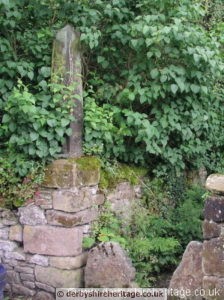  |
| RUNIC CROSS at All Saints churchyard in Bakewell
This ornate Runic Cross is one of two ninth century Saxon crosses in All Saints churchyard at Bakewell and stands in an enclosure near the south transept – the second one is known as Beeley cross.
|
BEELEY or TWO DALES CROSS in Bakewell churchyard
Two Dales or Beeley cross now stands in Bakewell churchyard along with another Saxon cross. It is in good condition due in part to it having been buried for some time.
from ‘Crosses of the Peak District’ –
Beeley Cross
This wayside cross has had an interesting recent history. In the grounds of Holt House in Two Dales about a mile north-east of Darley Bridge there once stood an ancient cross-shaft. There are two differing explanations as to how the cross came to be in this position, but both follow similar lines. The first explanation is that the shaft was discovered at some date during the nineteenth century in the fields near Burley Fields Farm (SK276642) by farm workers who found it lying under two feet of earth. The owner of the land at the time was also the owner of Holt House and he had it brought there and set up on a solid base. In another account the cross was found in the 20-acre field about 600 yards northwest of Screetham Farm House near Gladwin’s Mark Farm beside Beeley Lane. This would be in the area SK299672. Either or neither of these explanations might be true; the second would lie beside the Chatsworth to Alfreton road which probably follows the same line as an earlier packhorse track, a typical site for a roadside cross, and therefore the more likely. Burdett’s map shows an old track to support this suggestion and fails to show a similar track passing close to Burley Fields Farm.
Beeley Moor Cross in Bakewell Churchyard
G.H.B. Ward was in no doubt as to the original situation of the cross. On the reverse of document F17L in Sheffield Library he wrote:
“The Saxon Cross In Holt House grounds at Darley Dale and described by T.L.Tudor in Derbyshire Archaeological Journal in 1936 was not found where stated but in the Twenty Acre Field about 600 Yards North west of Screetham Farm House and as I proved on the spot with S.O. Kay (who was told by a retired gamekeeper). It is the first Saxon Cross which I have proved…..and came from beside the historic bridle road. It is beside the Chatsworth Alfreton bridleway as marked on this map. This history must be corrected. Possibly the owner of Holt House did not wish the site from which he obtained the cross to be known and informed Tudor wrongly.”
| Bradley Churchyard cross in the churchyard of Bradley All Saints, Bradley near Ashbourne 
|
Clifton cross base
In the garden of a Thorpe private house stands the base of the Clifton Cross. This was originally from near Ashbourne, on the road from Ashbourne to Lichfield. It formerly stood at SK168453 and was a square section cross as can still be seen from where it was leaded into the base. Originally there was a face carved on each corner but these are now so badly eroded as to be almost unrecognisable.
There was also another cross at Clifton, the Clifton Butter Cross which was outside the Cock Inn in the 1960’s. It was plain, cylindrical and about 16 inches high. It has since disappeared.
| Edale Cross This cross, made from local gritstone and quite coarsely carved, is believed to be medieval in date and was probably erected by the Cistercian monks of Basingwerk Abbey at the southern boundary of land which they received from Henry II in 1157. 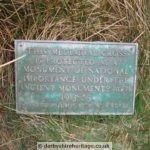 The cross was thrown down from its original position and its base and part of the shaft are missing. It was found buried in peat by local farmers who re-erected it and carved their initials onto the front with the date 1810.from Historic England it is is scheduled under the Ancient Monuments and Archaeological Areas Act 1979 The cross was thrown down from its original position and its base and part of the shaft are missing. It was found buried in peat by local farmers who re-erected it and carved their initials onto the front with the date 1810.from Historic England it is is scheduled under the Ancient Monuments and Archaeological Areas Act 1979The monument, known both as Edale Cross and Champion Cross, is situated below Kinderlow in the northern gritstone moorlands of the Derbyshire Peak District. It includes a freestanding medieval wayside and boundary cross which stands on the parish boundary between Hayfield and Edale next to the ancient moorland track between the two villages. It also marked the edge of the former royal forest of Peak Forest. from Wikipedia – The first cross on the site may have been set up by the Abbots of Basingwerk Abbey to mark the southern boundary of their land, granted in 1157. The date of the current cross is unknown, although a plaque beside it claims it to be mediaeval. At some point it fell down, and was re-erected in 1810, when the date and initials JG, WD, GH, JH and JS were carved into it. These stand for John Gee, William Drinkwater, George and Joseph Hadfield and John Shirt, local farmers of the day who raised the cross.   |
| FOX LANE CROSS – SK297754 It is thought that this may have been a parish boundary marker and it is easily accessed from Fox Lane close by is Shillito Wood cross   |
| ECCLES CROSS – Hope churchyard Eccles Cross now stands in Hope Churchyard but it was originally a wayside cross standing at SK175831. As stone churches came to be built, ‘Holy crosses’ were placed along outlying tracks to guide travellers to them and this cross was sited on an old track leading directly to the church. When the Rev. Cox was examining crosses in 1904 he refers to it as: “another medieval base and part of a shaft in a field on the high ground to the south of Hope Church.” St Peter’s cross is also here. |
   |
| ST PETER’S CROSS – HOPE CHURCHYARD There was a church and priest in Hope before the Norman Conquest, nothing remains of the Saxon church except the cross mounted in a modern base. It is believed to date from the time of King Alfred, was hidden on the fabric of Hope School from the time of the Civil War until 1858 when it was discovered during demolition of the school house. Its excellent state is due to it having been buried in a wall for two hundred years and close by the sundial and part of a guidestoop.  Opposite the South church door is a Calvary of five octagonal steps with a sundial pillar mounted in an octagon base on top. The base has a square hole in it which would accommodate the Saxon cross shaft. It is supposed that it was once mounted on the calvary but this is more typical of a market cross. Eccles cross is also in the churchyard. |
| SHILLITO WOOD CROSS – SK296748 Variously known as Shillito Wood or Bole Hill Cross it was also the Shepherd’s Cross on the Victorian Ordnance Survey map. It is to be found in the wood by the car park south of Fox Lane cross.  |
| Stoney Middleton Corn Laws cross Inscribed 1846, this cross was erected to celebrate the repeal of the Corn Laws of 1846 which benefited the working class.  |
| TISSINGTON CROSS BASE This old and badly worn cross base with no cross shaft can be found near the churchyard wall on the north side of the church. 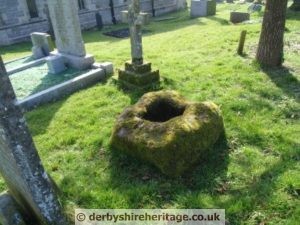 |
| Wheston cross |
| Wormhill churchyard cross Part of a plain cross raised on steps. A sundial has been fixed onto the broken shaft which is inscribed – “The gift of Robert Meverell, gent. G.R. fecit 1670”.  |



